Global Synthetic Rope Market, By Material Type, By Application, By Region & Segmental Insights Trends and Forecast, 2024 – 2034
- Industry: Chemicals & Materials
- Report ID: TNR-110-1185
- Number of Pages: 420
- Table/Charts : Yes
- June, 2024
- Base Year : 2024
- No. of Companies : 10+
- No. of Countries : 29
- Views : 10141
- Covid Impact Covered: Yes
- War Impact Covered: Yes
- Formats : PDF, Excel, PPT
In Terms of Revenue, the Global Synthetic Rope Market was Worth US$ 3.5 Bn in 2023 and is Anticipated to Witness a CAGR of 7.3% During 2024 – 2034.
Synthetic rope is a type of rope made from artificial fibers like nylon, polyester, polypropylene, and high-performance fibers such as Dyneema and Kevlar. It is known for its high strength-to-weight ratio, durability, resistance to chemicals, and ease of handling, making it ideal for various applications, including marine, industrial, sports, and safety equipment. Synthetic ropes are widely used in various applications, including marine and offshore operations, where they serve as mooring lines, towing lines, and anchor lines. In the industrial sector, they are used for lifting, rigging, and securing loads. Additionally, synthetic ropes are popular in recreational activities like climbing, sailing, and fishing, as well as in safety and rescue operations.
The synthetic rope market is experiencing significant growth due to its widespread adoption across diverse industries. Key trends include increasing demand for lightweight and high-strength materials, advancements in fiber technology, and growing applications in marine and offshore sectors. Opportunities are emerging from the construction industry, renewable energy sector, and the rising popularity of recreational activities like climbing and sailing. Growth drivers include the superior properties of synthetic ropes over traditional materials, such as steel and natural fibers, increasing investments in infrastructure projects, and expanding maritime activities. Additionally, the need for safety and efficiency in industrial operations further propels the market growth.
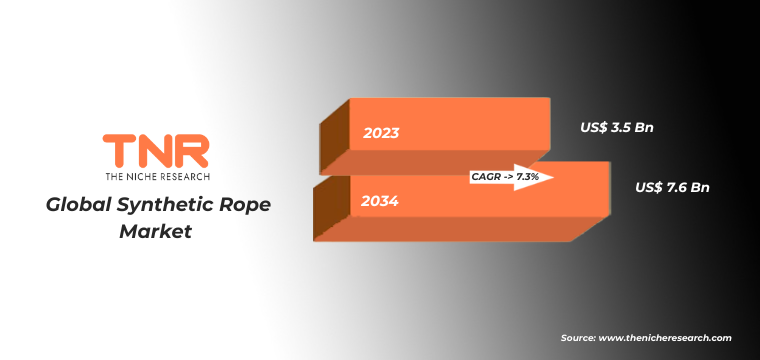
Synthetic Rope Market Dynamic
Growth Driver-
Increasing Demand for Lightweight and High-Strength Materials in Various Industries
Traditional ropes made from steel or natural fibers are often heavy and less durable, which can limit their efficiency and lifespan. Synthetic ropes, on the other hand, offer a superior strength-to-weight ratio, making them easier to handle and reducing the overall load. This advantage is particularly crucial in industries such as marine, where reducing weight can enhance fuel efficiency and performance. Additionally, synthetic ropes are resistant to corrosion, UV light, and chemicals, which extends their durability and reliability. These benefits drive their adoption across sectors like construction, shipping, and offshore oil and gas, fueling market growth.
Trends-
Increasing Adoption of High-Performance Fibers
Advanced materials offer exceptional strength, durability, and resistance to extreme conditions compared to traditional synthetic fibers like nylon and polyester. The demand for these high-performance ropes is rising in industries requiring superior performance, such as offshore oil and gas, defense, and aerospace. Moreover, the recreational and sports sectors are also leveraging these ropes for activities like climbing and sailing, where safety and reliability are paramount. The trend towards using these cutting-edge materials is driven by their ability to enhance operational efficiency, safety, and longevity, meeting the evolving needs of various high-demand applications.
Challenge-
High Cost of Advanced High-Performance Fibers
Advanced materials, while offering superior strength, durability, and resistance to harsh conditions, are considerably more expensive than traditional fibers like nylon and polyester. The elevated cost can be a barrier for widespread adoption, especially in cost-sensitive industries or applications where budget constraints are critical. Additionally, the production of these advanced fibers involves complex manufacturing processes, contributing to the higher prices. This price factor can limit market penetration and compel some users to opt for less expensive alternatives, even if they offer lower performance. Overcoming this challenge requires innovations to reduce production costs and enhance the affordability of high-performance synthetic ropes.
Synthetic Rope Market Segmentation by Material Type, Application, Region
Polypropylene segment is set to dominate the synthetic rope market, commanding a substantial revenue share of 34.3% over the forecast period.
Polypropylene ropes are highly favored due to their excellent properties, such as lightweight, buoyancy, and resistance to chemicals, moisture, and abrasion. These characteristics make them ideal for a wide range of applications, particularly in the marine and fishing industries, where they are used for mooring lines, towing lines, and fishing nets. Moreover, the cost-effectiveness of polypropylene compared to other synthetic fibers such as nylon or high-performance materials like Dyneema and Kevlar, further drives its popularity.
Its affordability without compromising essential performance aspects attracts industries that require large volumes of rope. Additionally, the growing demand for recreational activities such as sailing and boating, where polypropylene ropes are commonly used, contributes to its market dominance. The versatility, durability, and economic advantages of polypropylene ropes ensure their significant market share and continued growth in the synthetic rope market.
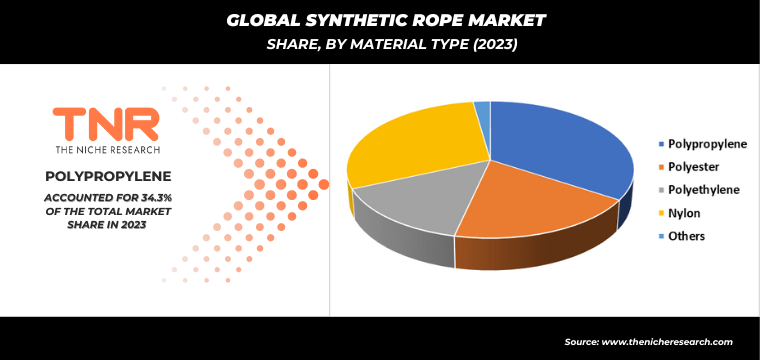
Industrial segment is anticipated to be the fastest-growing application in the synthetic rope market, capturing a substantial revenue share of 19.6% over the forecast period.
This growth is driven by the increasing demand for synthetic ropes in various industrial applications, including construction, mining, manufacturing, and utilities. Synthetic ropes are preferred in these sectors due to their high strength-to-weight ratio, ease of handling, and superior resistance to environmental factors such as chemicals, UV light, and moisture. In construction and mining, synthetic ropes are used for lifting, rigging, and securing loads, where their lightweight nature enhances safety and efficiency.
The manufacturing sector benefits from synthetic ropes in material handling and transportation, reducing operational downtime and maintenance costs. Additionally, the growing emphasis on workplace safety and operational efficiency in industrial operations further propels the adoption of synthetic ropes. The versatility and durability of synthetic ropes make them an indispensable tool in the industrial sector, driving their rapid market growth and significant revenue share.
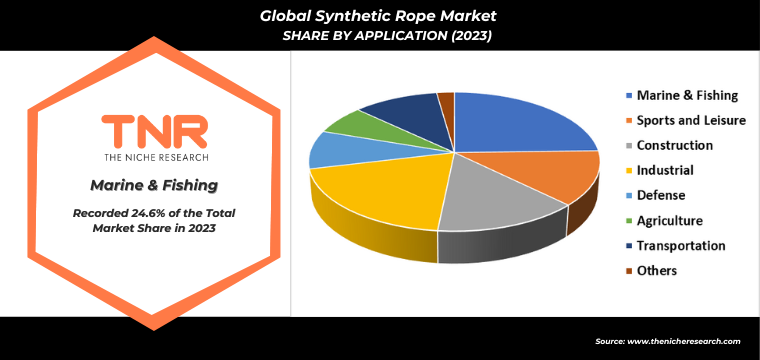
In 2023, Asia Pacific is anticipated to play a significant role in propelling the growth of the synthetic rope market, contributing approximately 36.7% to its overall expansion.
This region’s robust growth is driven by rapid industrialization, urbanization, and the burgeoning construction sector in countries like China, India, and Japan. The demand for synthetic ropes in these areas is bolstered by extensive infrastructure projects, including bridges, roads, and high-rise buildings, where the ropes’ lightweight, high strength, and durability are invaluable. Moreover, the thriving maritime industry in Asia Pacific, encompassing shipping, fishing, and offshore oil and gas exploration, heavily relies on synthetic ropes for various applications.
The region’s significant investments in renewable energy, particularly wind energy projects, also drive the demand for synthetic ropes used in turbine installation and maintenance. The combination of economic growth, industrial expansion, and increased focus on renewable energy and infrastructure development ensures Asia Pacific’s substantial contribution to the synthetic rope market’s overall growth.
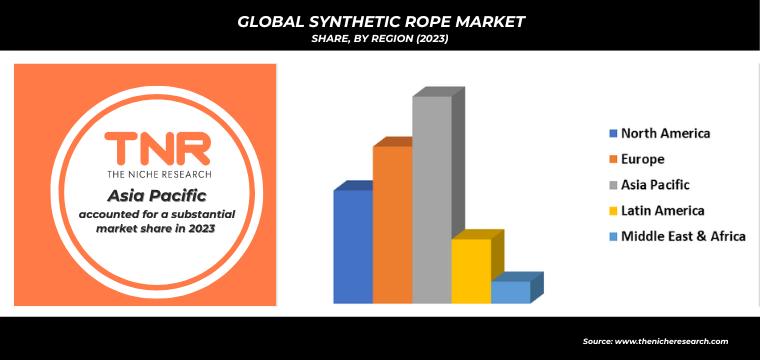
Major Players in Synthetic Rope Market
- Bridon-Bekaert
- Cortland Limited
- Katradis Marine Ropes Ind. S.A.
- LANEX a.s.
- Marlow Ropes
- Southern Ropes
- TEUFELBERGER
- WireCo WorldGroup
- Yale Cordage
- Other Industry Participants
Global Synthetic Rope Market Scope
| Report Specifications | Details |
| Market Revenue in 2023 | US$ 3.5 Bn |
| Market Size Forecast by 2034 | US$ 7.6 Bn |
| Growth Rate (CAGR) | 7.3% |
| Historic Data | 2016 – 2022 |
| Base Year for Estimation | 2023 |
| Forecast Period | 2024 – 2034 |
| Report Inclusions | Market Size & Estimates, Market Dynamics, Competitive Scenario, Trends, Growth Factors, Market Determinants, Key Investment Segmentation, Product/Service/Solutions Benchmarking |
| Segments Covered | By Material Type, By Application, By Region |
| Regions Covered | North America, Europe, Asia Pacific, Middle East & Africa, Latin America |
| Countries Covered | U.S., Canada, Mexico, Rest of North America, France, The UK, Spain, Germany, Italy, Nordic Countries (Denmark, Finland, Iceland, Sweden, Norway), Benelux Union (Belgium, The Netherlands, Luxembourg), Rest of Europe, China, Japan, India, New Zealand, Australia, South Korea, Southeast Asia (Indonesia, Thailand, Malaysia, Singapore, Rest of Southeast Asia), Rest of Asia Pacific, Saudi Arabia, UAE, Egypt, Kuwait, South Africa, Rest of Middle East & Africa, Brazil, Argentina, Rest of Latin America |
| Key Players | Bridon-Bekaert, Cortland Limited, Katradis Marine Ropes Ind. S.A., LANEX a.s., Marlow Ropes, Southern Ropes, TEUFELBERGER, WireCo WorldGroup, Yale Cordage |
| Customization Scope | Customization allows for the inclusion/modification of content pertaining to geographical regions, countries, and specific market segments. |
| Pricing & Procurement Options | Explore purchase options tailored to your specific research requirements |
| Contact Details | Consult With Our Expert
Japan (Toll-Free): +81 663-386-8111 South Korea (Toll-Free): +82-808- 703-126 Saudi Arabia (Toll-Free): +966 800-850-1643 United Kingdom: +44 753-710-5080 United States: +1 302-232-5106 E-mail: askanexpert@thenicheresearch.com
|
Global Synthetic Rope Market
By Material Type
- Polypropylene
- Polyester
- Polyethylene
- Nylon
- Others
By Application
- Marine & Fishing
- Commercial Fishing
- Recreational Marine
- Offshore Mooring
- Sports and Leisure
- Climbing
- Water Sports
- Adventure Sports
- Construction
- Lifting and Rigging
- Safety and Fall Protection
- Industrial
- Mining
- Oil & Gas
- Utilities
- Defense
- Military Operations
- Aerospace
- Agriculture
- Transportation
- Others
By Region
- North America (U.S., Canada, Mexico, Rest of North America)
- Europe (France, The UK, Spain, Germany, Italy, Nordic Countries (Denmark, Finland, Iceland, Sweden, Norway), Benelux Union (Belgium, The Netherlands, Luxembourg), Rest of Europe)
- Asia Pacific (China, Japan, India, New Zealand, Australia, South Korea, Southeast Asia (Indonesia, Thailand, Malaysia, Singapore, Rest of Southeast Asia), Rest of Asia Pacific)
- Middle East & Africa (Saudi Arabia, UAE, Egypt, Kuwait, South Africa, Rest of Middle East & Africa)
- Latin America (Brazil, Argentina, Rest of Latin America)
Report Layout:
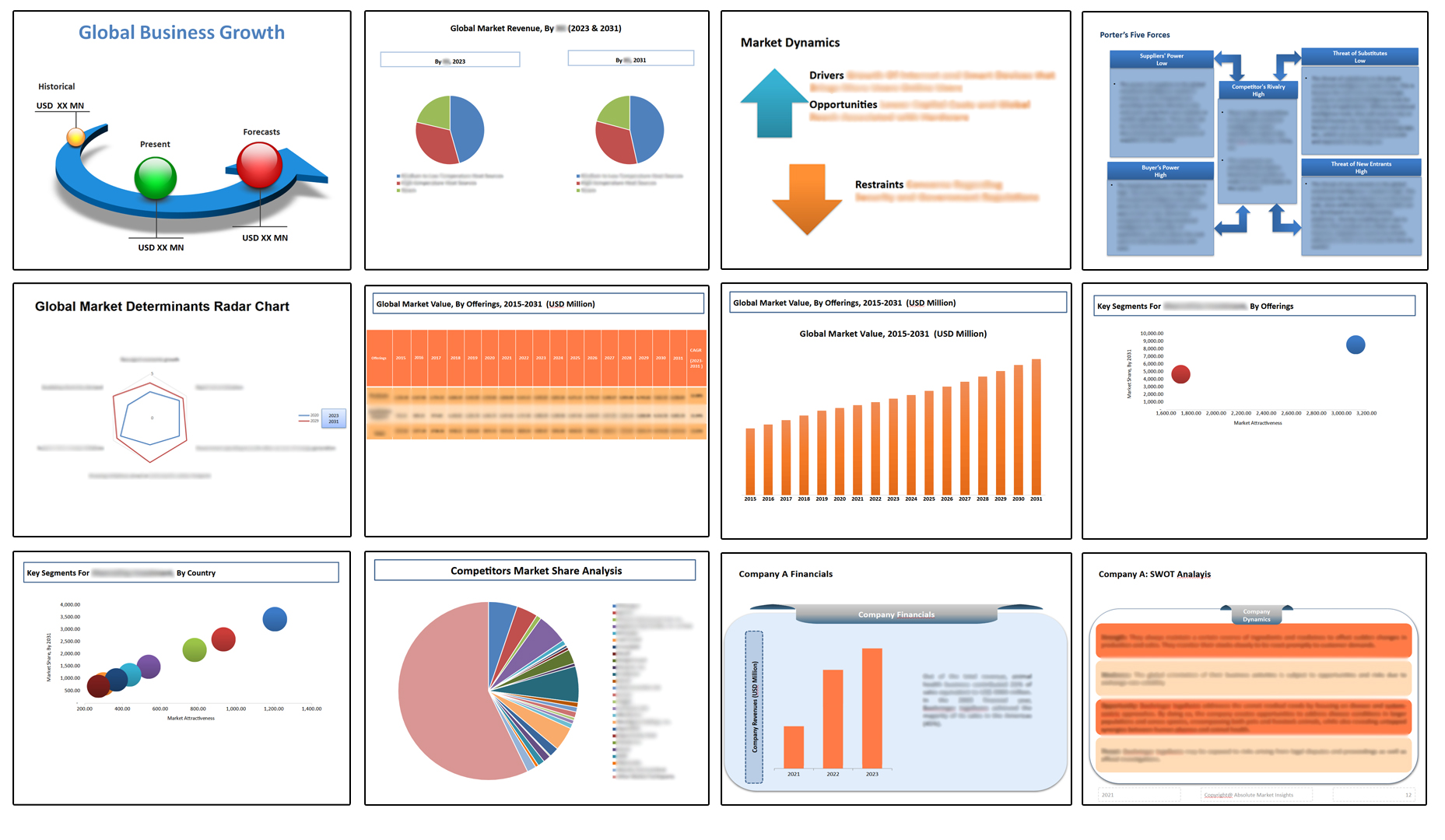
Table of Contents
Note: This ToC is tentative and can be changed according to the research study conducted during the course of report completion.
**Exclusive for Multi-User and Enterprise User.
Global Synthetic Rope Market
By Material Type
- Polypropylene
- Polyester
- Polyethylene
- Nylon
- Others
By Application
- Marine & Fishing
- Commercial Fishing
- Recreational Marine
- Offshore Mooring
- Sports and Leisure
- Climbing
- Water Sports
- Adventure Sports
- Construction
- Lifting and Rigging
- Safety and Fall Protection
- Industrial
- Mining
- Oil & Gas
- Utilities
- Defense
- Military Operations
- Aerospace
- Agriculture
- Transportation
- Others
By Region
- North America (U.S., Canada, Mexico, Rest of North America)
- Europe (France, The UK, Spain, Germany, Italy, Nordic Countries (Denmark, Finland, Iceland, Sweden, Norway), Benelux Union (Belgium, The Netherlands, Luxembourg), Rest of Europe)
- Asia Pacific (China, Japan, India, New Zealand, Australia, South Korea, Southeast Asia (Indonesia, Thailand, Malaysia, Singapore, Rest of Southeast Asia), Rest of Asia Pacific)
- Middle East & Africa (Saudi Arabia, UAE, Egypt, Kuwait, South Africa, Rest of Middle East & Africa)
- Latin America (Brazil, Argentina, Rest of Latin America)
The Niche Research approach encompasses both primary and secondary research methods to provide comprehensive insights. While primary research is the cornerstone of our studies, we also incorporate secondary research sources such as company annual reports, premium industry databases, press releases, industry journals, and white papers.
Within our primary research, we actively engage with various industry stakeholders, conducting paid interviews and surveys. Our meticulous analysis extends to every market participant in major countries, allowing us to thoroughly examine their portfolios, calculate market shares, and segment revenues.
Our data collection primarily focuses on individual countries within our research scope, enabling us to estimate regional market sizes. Typically, we employ a bottom-up approach, meticulously tracking trends in different countries. We analyze growth drivers, constraints, technological innovations, and opportunities for each country, ultimately arriving at regional figures.Our process begins by examining the growth prospects of each country. Building upon these insights, we project growth and trends for the entire region. Finally, we utilize our proprietary model to refine estimations and forecasts.
Our data validation standards are integral to ensuring the reliability and accuracy of our research findings. Here’s a breakdown of our data validation processes and the stakeholders we engage with during our primary research:
- Supply Side Analysis: We initiate a supply side analysis by directly contacting market participants, through telephonic interviews and questionnaires containing both open-ended and close-ended questions. We gather information on their portfolios, segment revenues, developments, and growth strategies.
- Demand Side Analysis: To gain insights into adoption trends and consumer preferences, we reach out to target customers and users (non-vendors). This information forms a vital part of the qualitative analysis section of our reports, covering market dynamics, adoption trends, consumer behavior, spending patterns, and other related aspects.
- Consultant Insights: We tap into the expertise of our partner consultants from around the world to obtain their unique viewpoints and perspectives. Their insights contribute to a well-rounded understanding of the markets under investigation.
- In-House Validation: To ensure data accuracy and reliability, we conduct cross-validation of data points and information through our in-house team of consultants and utilize advanced data modeling tools for thorough verification.
The forecasts we provide are based on a comprehensive assessment of various factors, including:
- Market Trends and Past Performance (Last Five Years): We accurately analyze market trends and performance data from preceding five years to identify historical patterns and understand the market’s evolution.
- Historical Performance and Growth of Market Participants: We assess the historical performance and growth trajectories of key market participants. This analysis provides insights into the competitive landscape and individual company strategies.
- Market Determinants Impact Analysis (Next Eight Years): We conduct a rigorous analysis of the factors that are projected to influence the market over the next eight years. This includes assessing both internal and external determinants that can shape market dynamics.
- Drivers and Challenges for the Forecast Period:Identify the factors expected to drive market growth during the forecast period, as well as the challenges that the industry may face. This analysis aids in deriving an accurate growth rate projection.
- New Acquisitions, Collaborations, or Partnerships: We keep a close watch on any new acquisitions, collaborations, or partnerships within the industry. These developments can have a significant impact on market dynamics and competitiveness.
- Macro and Micro Factors Analysis:A thorough examination of both macro-level factors (e.g., economic trends, regulatory changes) and micro-level factors (e.g., technological advancements, consumer preferences) that may influence the market during the forecast period.
- End-User Sentiment Analysis: To understand the market from the end-user perspective, we conduct sentiment analysis. This involves assessing the sentiment, preferences, and feedback of the end-users, which can provide valuable insights into market trends.
- Perspective of Primary Participants: Insights gathered directly from primary research participants play a crucial role in shaping our forecasts. Their perspectives and experiences provide valuable qualitative data.
- Year-on-Year Growth Trend: We utilize a year-on-year growth trend based on historical market growth and expected future trends. This helps in formulating our growth projections, aligning them with the market’s historical performance.
Research process adopted by TNR involves multiple stages, including data collection, validation, quality checks, and presentation. It’s crucial that the data and information we provide add value to your existing market understanding and expertise. We have also established partnerships with business consulting, research, and survey organizations across regions and globally to collaborate on regional analysis and data validation, ensuring the highest level of accuracy and reliability in our reports.















